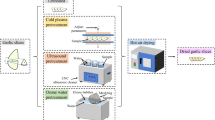Abstract
Ginger rhizomes sliced to various lengths of 5, 10, 15, 20, 30, 40, 50 mm and whole rhizomes were dried from an initial moisture content of 81.3 % to final moisture content of less than 10 % by various drying methods like sun drying, solar tunnel drying and cabinet tray drying at temperatures of 50, 55, 60 and 65 °C. Slicing of ginger rhizomes significantly reduced the drying time of ginger in all the drying methods. It was observed that drying of whole ginger rhizomes under sun took the maximum time (9 days) followed by solar tunnel drying (8 days). Significant reduction in essential oil and oleoresin content of dry ginger was found as the slice length decreased. The important constituents of ginger essential oil like zingiberene, limonene, linalool, geraniol and nerolidol as determined using a gas chromatography was also found to decrease during slicing and as the drying temperature increased. The pungency constituents in the oleoresin of ginger like total gingerols and total shogoals as determined using a reverse phase high performance liquid chromatography also showed a decreasing trend on slicing and with the increase in drying temperature. It was observed from the drying studies that whole ginger rhizomes dried under sun drying or in a solar tunnel drier retained the maximum essential oil (13.9 mg/g) and oleoresin content (45.2 mg/g) of dry ginger. In mechanical drying, the drying temperature of 60 °C was considered optimum however there was about 12.2 % loss in essential oil at this temperature.

Similar content being viewed by others
References
AOAC (1975) Official methods of analysis, 10th edn. Association of Official Analytical Chemists, Washington D.C
ASTA (1968) Official analytical methods, 2nd edn. American Spice Trade Association, New Jersey
Balakrishnan KV (2005) Postharvest and industrial processing of ginger. In: Ravindran PN, Nirmal Babu K (eds) Ginger-The genus Zingiber. CRC Press, Boca Raton, Florida, pp 391–434
Connell DW, Sutherland MD (1969) Re-examination of gingerol, shogaol and zingerone, the pungent principles of ginger. Aust J Chem 22:1033–1043
Gopalam A, Ratnambal MJ (1989) Essential oils of ginger. Indian Perfum 33(1):63–69
ISO IS:13685 (1997) Ginger and its oleoresins—determination of the main pungent components (Gingerols and shogoals)—method using high performance liquid chromatography. International Organization for Standardization, Geneva
Mathew AG, Krishnamurthy N, Nambudri ES, Lewis YS (1973) Oil of ginger. Flavour Ind 3:78–81
Narayanan CS, Mathew AG (1985) Chemical investigation on spice oils. Indian Perfum 29(1–2):15–22
Purseglove JW, Brown EG, Green CL, Robbins SRJ (1981) Ginger. Spices, vol 2. Longman, New York, pp 447–531
Rani K (1999) Cyclization of farnesyl pyrophosphatateinto sesquiterpenoids in ginger rhizomes (Zingiber officinale). Fitoterapia 70(6):568–574
Spices Board (2011) Spices Board of India. http://indianspices.com. Accessed 1 Aug 2011
Author information
Authors and Affiliations
Corresponding author
Electronic supplementary material
Below is the link to the electronic supplementary material.
ESM 1
(PDF 2194 kb)
Rights and permissions
About this article
Cite this article
E., J., R., V. & T., J.Z. Quality of dry ginger (Zingiber officinale) by different drying methods. J Food Sci Technol 51, 3190–3198 (2014). https://doi.org/10.1007/s13197-012-0823-8
Revised:
Accepted:
Published:
Issue Date:
DOI: https://doi.org/10.1007/s13197-012-0823-8




